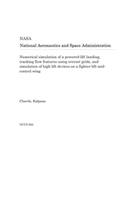
Numerical Simulation of a Powered-Lift Landing, Tracking Flow Features Using Overset Grids, and Simulation of High Lift Devices on a Fighter-Lift-And-Control Wing
Series:
Attached as appendices to this report are documents describing work performed on the simulation of a landing powered-lift delta wing, the tracking of flow features using overset grids, and the simulation of flaps on the Wright Patterson Lab's fighter-lift-and-control (FLAC) wing. Numerical simulation of a powered-lift landing includes the computation of flow about a delta wing at four fixed height
NaN
VOLUME
English
Paperback

Attached as appendices to this report are documents describing work performed on the simulation of a landing powered-lift delta wing, the tracking of flow features using overset grids, and the simulation of flaps on the Wright Patterson Lab's fighter-lift-and-control (FLAC) wing. Numerical simulation of a powered-lift landing includes the computation of flow about a delta wing at four fixed heights as well as a simulated landing, in which the delta wing descends toward the ground. Comparison of computed and experimental lift coefficients indicates that the simulations capture the qualitative trends in lift-loss encountered by thrust-vectoring aircraft operating in ground effect. Power spectra of temporal variations of pressure indicate computed vortex shedding frequencies close to the jet exit are in the experimentally observed frequency range; the power spectra of pressure also provide insights into the mechanisms of lift oscillations. Also, a method for using overset grids to track dynamic flow features is described and the method is validated by tracking a moving shock and vortices shed behind a circular cylinder. Finally, Chimera gridding strategies were used to develop pressure coefficient contours for the FLAC wing for a Mach no. of 0.18 and Reynolds no. of 2.5 million. Chawla, Kalpana Unspecified Center NCC2-563...
Price Comparison [India]
In This Series
Bestseller Manga
Trending NEWS




















